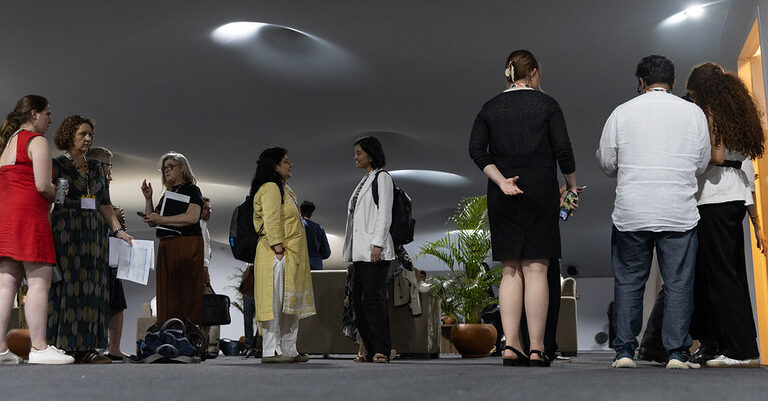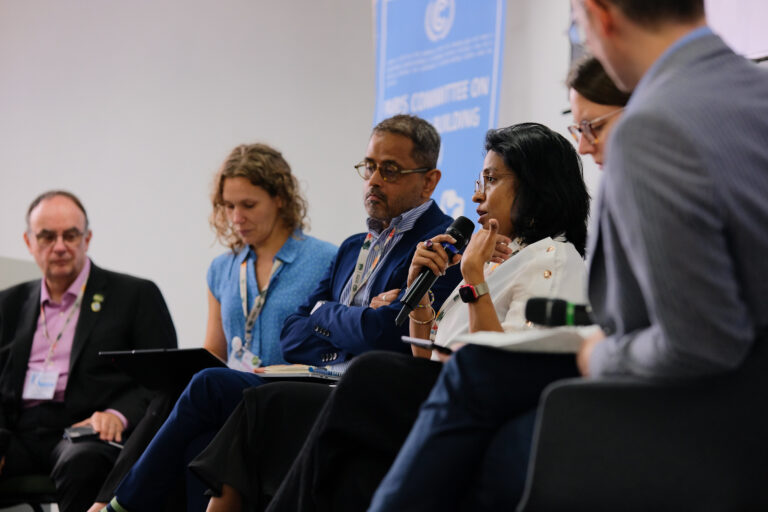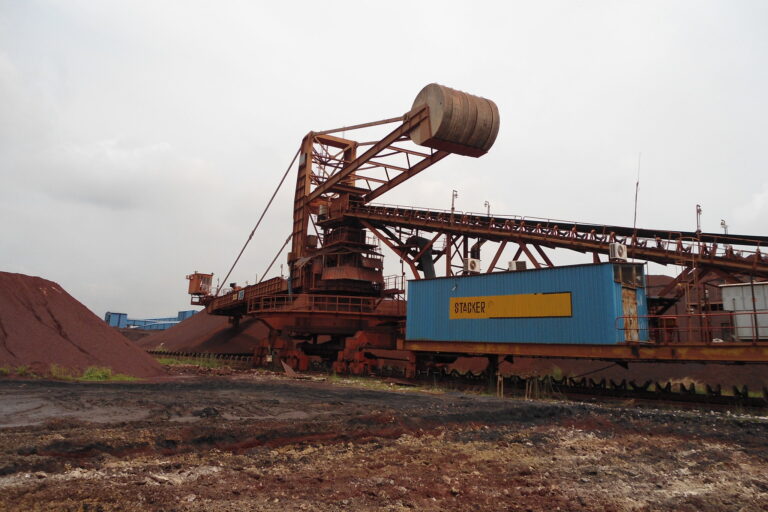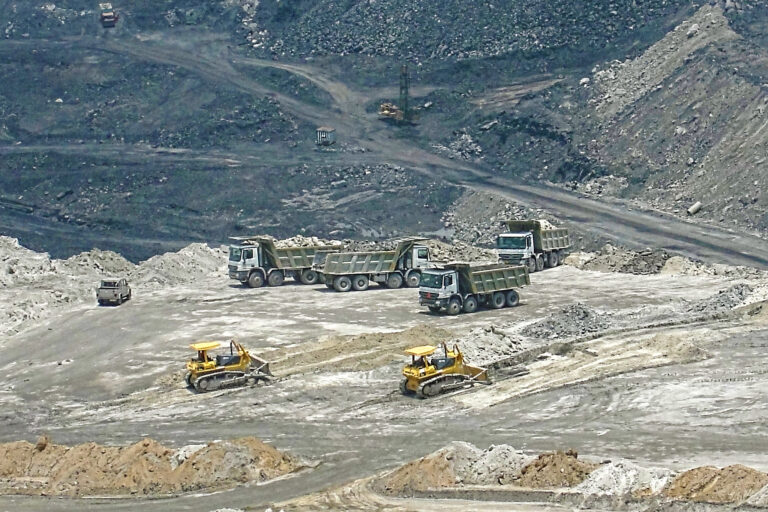- With the elections for the state assembly likely in the first half of 2021, the Kerala government has announced many projects that are environmentally controversial.
- Kerala had faced devastating floods and landslides in 2018 and 2019 proving that some of the past development projects had adverse environmental consequences.
- Even as the monsoon has begun in the state, some of the new projects announced are bringing back past memories.
With Kerala all set to face yet another assembly election in the coming year (2021), a series of policy decisions taken by the Left Democratic Front (LDF) government, to clear environmentally controversial projects with possibly very serious impacts on the state’s fragile ecosystem, are evoking widespread concern.
Clearance for a new greenfield airport at an ecologically fragile portion of the Western Ghats close to famous pilgrim station Sabarimala, green signal for a multi-crore semi high-speed rail corridor with huge ecological and social effects, attempts to quarry and transport sand from river Pampa near Sabarimala, go ahead for the controversial Athirappilly hydel power project in Thrissur district, and lifting of a long enforced blanket ban on illegal quarries across the state are some of the issues of high environmental concerns in Kerala.
Though there have been community protests against these projects, the state government is using the prevailing lockdown as an excuse to move forward all these projects, which would create long term impacts on the state’s environmental and social equilibria.
New airport near Sabarimala
While the state government is facing extreme financial constraints in the ongoing fight against the COVID pandemic, what has raised eyebrows is the move to set up a full-fledged international greenfield airport about 48 km from the famous pilgrim centre of Sabarimala.
The airport would be the fifth in the small state, while its fourth airport (established in Kannur) is yet to emerge as an economically viable project. The proposed airport project, however, has been stayed by the Kerala High Court.
The proposed airport will come up in a 2263-acre rubber plantation, named Cheruvally Estate, which was created during the British rule. In the process, the government is choosing to ignore all environmental laws apart from the Kerala rules related to land reforms and land redistribution. The rules direct the government to take over the defunct estates with expired lease agreements and either convert them as forests or distribute them among landless people.
Though many serious changes in land use patterns have occured in the area over the years, the proposed airport site continues to remain environmentally crucial because a number of streams contributing to the River Pampa are flowing through the estate. These will be reclaimed once the works of the airport would begin.
As the lease period of the plantation has already expired, the land was needed to integrate with surrounding forests to expand green cover of the region, which was under threat in the recent years due to heavy flow of pilgrims to Sabarimala and subsequent commercial activity on the hills.
According to environmental activist John Peruvanthanam, the construction of the airport would cause razing down of several hillocks in the present estate, in which pineapple is being cultivated now. The hillocks are crucial for the local environment, he said. Large scale commercial activity as part of the airport would adversely affect the fragile ecology of Pampa and Sabarimala portions of Western Ghats, which are already under stress, he pointed out.
“The area had seen large scale flooding and devastation in the last two annual floods. The situation may turn bizarre once the airport comes. Cochin International Airport constructed on low lying paddy fields is getting closed during every monsoon due to massive flooding. Same may be the situation here also. Above all, the government is yet to make public the environmental impact study on the new airport project. Authorities are bound to release it early,” he said.
Location of Cheruvally Estate where the airport is proposed for Sabarimala. Source: Google Maps.
Semi high-speed railway
As Kerala is inching toward another assembly election in another one year, an ambitious project announced by the state government in the recent days to reduce train travel distance between state capital Thiruvananthapuram and northern town Kasargod has also invited angry reactions from environmentalists and even experts on infrastructure projects.
Named Silverline Project, the high-speed railway facility which would run parallel to the existing Kasargod-Thiruvananthapuram railway line is worth Rs 640 billion. It is expected to reduce the travel time between the two cities to around four hours from the present time of nearly 10 hours.
While experts term it as a white elephant, families in different parts of the state who would be displaced by the project say they are apprehensive about the idea. Over a dozen action councils have been formed across the state to protest against it.
“The land acquisition for the project would cause severe environmental impact apart from displacing many in this state known for its high density of population. Many wetlands, rivers, rice fields, lakes and forest areas would be affected adversely. Many people would be displaced. The project would demand more granite and loose soil from Western Ghats. Ultimately, it is a white elephant with no real benefit to the people,’’ pointed out Santhosh Thannikkat, an expert who researched on the feasibility of the project.
“The existing rail lines of the state are not efficiently used so far. Even track doubling of the lines via Kottayam and Alappuzha have been incomplete for more than two decades. The new project requires acquisition of over 9000 hectares. Kerala is presently connected by airports and cheap flights can ensure more comfort to people than the high-speed railway, which would turn more costly,” said Santhosh.
“It’s not just an issue of financial viability. Even its necessity should be reviewed. Travel time has never been a factor that affected Kerala’s industrial growth. The environmental and social costs of the project are enormous,” said D. Dhanuraj, chairman of Kochi-based Centre for Public Policy Research.
A video on the proposed alignment for the Silverline Project prepared by the Kerala Rail Development Corporation.
Mineral sand mining at Thottappally
Despite the lockdown, surroundings of ecologically fragile Thottappally estuary in Kerala’s Alappuzha district now look almost like a beehive of activity. One of the major direct outlets to the sea from the Vembanad backwater ecosystem, spread in Alappuzha and Ernakulam districts of the state, Thottappally is home to a number of reptiles, migratory birds and a large number of butterflies. In addition, olive ridley turtles come to the beach at Thottapally to lay eggs.
A unique manmade spillway in the area prevents saline water of the sea from getting mixed with Vembanad’s fresh waters, which support rice cultivation in vast expanses of low lying wetlands. Though no tourist is permitted to visit the scenic estuary due to COVID-19 lockdown, Thottappally has had an unprecedented kind of human presence since May 1.
A large posse of armed policemen are camping in the area to facilitate mining of mineral-rich sand from the estuary and load it into a large number of tippers lined up there. The mineral-rich sand is being transported to Chavara in Kollam district to be processed at the public sector Kerala Minerals and Metals Limited (KMML). According to government sources, the KMML has obtained permission from Kerala’s industries department to extract 200,000 cubic metre of sand from the estuary.
As per information available with Kerala government’s industries department, a total of 44,200 tonnes of mineral rich black sand was mined from the estuary during the 40 days which ended on June 30. In these days, 3400 truckloads of black sand with huge international demand were taken to Chavara.
But according to Saji Jayamohan, who heads local environmental action group Green Roots Nature Conservation Forum, the actual amount of extraction might be over ten times of this official figure. Hundreds of trucks are carrying the mineral rich sand round the clock from the estuary despite strong protests from the local community and environmentalists, he alleged.
“The state government is justifying its decision to extract the sand from the estuary and dredging of the area close to the spillway as measures to ensure smooth release of water from Kuttanad region during the possible annual deluge during the coming months,” the leader of the opposition in Kerala, Ramesh Chennithala told Mongabay-India.
“Nobody is against advance preparations to manage flood waters. But what is happening here is large-scale extraction of mineral-rich sand using lockdown as a cover. Through this, the government is extending mineral sand mining which has already ruined the entire coastal belt of Kollam district to the fragile shores of Alapauzha having a blend of both coastal and backwater ecosystems,” said Chennithala, who hails from nearby Haripad.
“If ensuring smooth discharge of water during the floods is the sole intention, the government should dredge only the main channel of the spillway and operate its shutters more efficiently. Indiscriminate removal of sand from the estuary will turn counterproductive and salt water would intrude into the low-lying Kuttanad,” added Jayamohan.
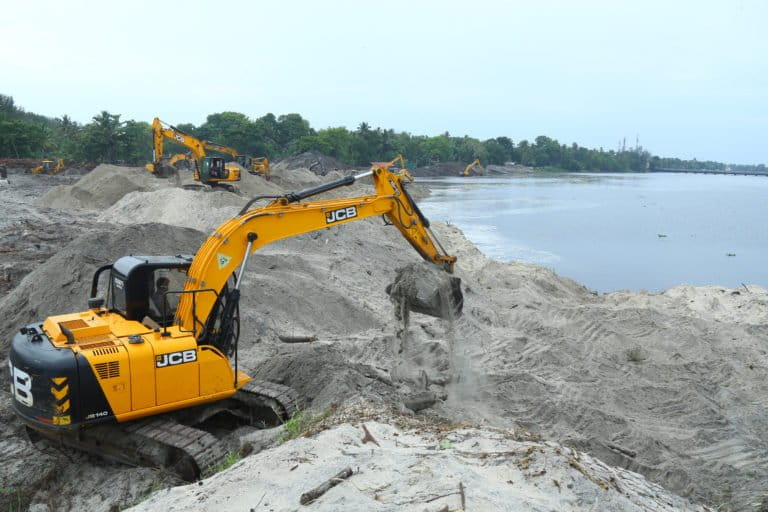
Sliding hill slopes
Kerala faced many environmental problems during the floods of 2018 and 2019. This year, in the Anamalai hills on the Western Ghats (where the famous hill station Munnar is located), there were 14 major landslides in a single location since the second week of May, when the monsoon rains started. The local community and environmentalists are attributing it to indiscriminate quarrying and unscientific expansion of the Kochi-Dhanushkodi national highway which passes through Munnar.
In a major landslide that occurred at the location named Gap Road during June first week, 200 meters of the new highway under construction was swept away apart from destroying over 13 acres of cardamom plantation. Two buildings on the slope were totally destroyed and another building partially. Communities living in Komalikkudy, Societykada, Kakkakada and Changanacherrykada areas of Munnar have been complaining about illegal quarrying and unscientific road widening.
When contacted by Mongabay-India, Devikulam sub collector R Premkrishnan said an expert team from National Institute of Technology (NIT) at Kozhikode will soon inspect the landslip close to the Kochi-Dhanushkodi national highway and submit a report. Only on the basis of the report, subsequent action would be taken, he said.
However, sources in the revenue department have confirmed that former sub collector Renuraj had submitted a report to the revenue principal secretary saying soil sensitivity of the area was not factored in while deciding to widen the highway. Though the report had warned about the chances of landslides in the area, the government chose to ignore it.
According to Siby Munnar, a local environmental activist, the contractor company which undertook the highway widening work had illegally removed more rocks from the road poramboke in the Munnar area. During construction, the earthmoving was done without erecting retaining walls on the slopes on the side of the road and that had increased possibilities of more landslides.
Sand removal from Pampa
The Southern Bench of the National Green Tribunal (NGT) has constituted a committee to look into the environmental impacts of removal of river sand from Pampa which the state government has permitted citing possibility of overflowing of the river during possible floods in the coming months. A major controversy erupted when the state government had invoked National Disaster Management Act for the `desilting’ of the river at Thriveni on the gateway to Sabarimala and transportation of the sand for commercial purposes.
The state’s own forest department had issued an order countermanding the earlier order issued by the district collector authorising the removal of sand. When Chief Minister Pinarayi Vijayan backed the Collector’s decision on the removal of sand and expressed displeasure over the Forest Department’s act, the issue has received state wide attention.
However, Kerala’s Industry Minister E P Jayarajan has said that it was the Disaster Management Authority that wanted the district administration to remove the accumulated sand or silt from Thriveni at Pampa as part of the State’s monsoon preparedness. However, highly placed sources in the forest department have confirmed that the issue became a controversy when the district administration deviated from its earlier decision to deposit the collected sand and sediment on sites specified by the forest department.
According to N.K. Sukumaran Nair of Pampa Parirakshana Samithy, the decision to remove sand and other debris from Pampa was taken arbitrarily by the government without carrying out any studies.
T.V. Sajeev, a scientist with Kerala Forest Research Institute, said that sand should not be removed from the river all of a sudden. “A sand audit is required before removing it. In every river, sand is integral to the river ecosystem and it is very critical for the continuous flow of water and for sustenance of aquatic life. If there is too much of accumulation, rivers have their own instinctive ways of adapting to the development,’’ he said.

Banner image: Mineral sand being mined at Thottapally beach. Photo by P.R. Suresh.








